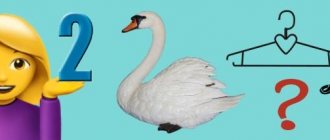In this article I will write about two possible options for teaching a child to swim: “express” (literally in 1-2 lessons) and “academic” (longer and higher-quality training).
Attention! This article is dedicated to teaching children aged 6-9 years and older. If you are interested in teaching for a younger age, I have a separate article devoted to this issue.
Features of school age
Unlike younger children, starting from 6-7 years old, the child is already ready for the learning process - ready to consciously perform exercises and tasks. It is from this age that people are accepted to study at a sports school.
In this regard, there is no longer a need to teach through games (as with little ones), and at the same time it is possible and necessary to instill in the child the correct swimming style.
However, in relation to schoolchildren, the parent’s task is to ensure that the child has a desire to take up swimming, that is, to interest him, and not to force him .
I would also like to note that under no circumstances should you scold a child if he has taken too much water - you need to treat it calmly (for more details, see here). The goal is for positive results to come from classes. Praise your child often.
Basics of proper swimming
I write about this in many articles on this site and, just in case, I will repeat it here again (if you have already read or understand the issue, feel free to move on to the next section of the article).
Correct swimming is swimming with your head in the water . Inhalation, of course, is done as a result of lifting (in breaststroke) or turning (in crawl) the head, exhaling into the water with your nose or mouth. This is the kind of swimming that needs to be taught.
Any person, and especially a child, instinctively strives to lift his head up - this is at least necessary for comfortable breathing. On the contrary, putting your face in the water and swimming in this position is not a very natural action for a person.
However, it is correct to swim with your face in the water:
- Firstly, a raised head upsets the balance of the body, and the legs and pelvis begin to sink .
- Secondly, it prevents the body from stretching and disrupts buoyancy.
- Thirdly, if we talk about long-term exercise, then pinched cervical vertebrae and compressed blood vessels are, at the very least, not good for health.
Correct head position in freestyle swimming
In addition, since we are talking about training, it is also much easier to learn swimming from scratch with your head down rather than with your head up. By lowering his face into the water and drawing air into his chest, even the most beginner will be able to float on the water like an asterisk (and this is half the way!), while with his head raised it will be extremely difficult for a beginner to stay on the water.
Your task is to teach your child to swim with his head in the water. This does not mean that he will swim like this all the time in the future. On the contrary, children who have learned then often bathe, swimming crawl with their heads raised. But they already know how to swim, that is, the task of teaching has been achieved.
How to overcome your fear of water?
If a student is afraid of water, you should not convince him otherwise. To achieve quick results, it is important that classes take place in a comfortable and safe environment. Parents should focus not on overcoming fear, but on creating a feeling of safety. You can do this as follows:
- give the opportunity to get used to the water. When the baby looks around and is not distracted by new sensations, it is worth talking about the properties of water. In age-appropriate language, tell them that water, if the body is positioned correctly, will keep it afloat and “push” it to the surface. Show that the ball does not sink in water, explain why this happens. The absence of fear will allow you to achieve the desired result faster;
- let you feel the ground under your feet. Do not rush to immediately take the student into depth. The water level to the chest is optimal in the first stages of training. Invite the future swimmer to play games. The “Fountain” exercise helps you get comfortable in the water: bend your knees slightly so that your lips are in the water. In this position, you should blow out air with your mouth until bubbles form. This activity will certainly entertain the child and help cope with anxiety. In the future, you can go to a depth where the water level reaches the collarbones.
When teaching, it is important to remain calm, not to rush the child, and not to raise your voice. A parent should be a “lifeline”, a “guide” on the path to the unknown. When the fear of water is left behind, they begin to learn to stay afloat. You shouldn’t delay this moment, because you get used to being in the water, touching the bottom.
Stay calm and be a confident guide for your child, not only in learning to swim, but in any other situation. Always know where your child is and what is happening around him so that you can provide him with timely help or support. Download the “Where are my children” application from the AppStore and GooglePlay stores.
Where to begin? Express option
As an option, try express training using the method suggested by trainer Denis Tarakanov.
It is usually not suitable for very young children, but from 6-7 years old it is quite possible to try it as a start.
Using this technique, you can teach a child to at least somehow swim in just one or two lessons .
This technique is clearly shown in the video of its author, I highly recommend watching it:
Here is the sequence of exercises to be performed. We do each exercise about 10 times, then move on to the next one:
- In the shallow part of the pool (where you can lie down and still reach the bottom), the child rests his hands on the bottom , lowers his face into the water, relaxes his neck - do this 10 times.
- Do the same, but additionally lift one hand from the bottom.
- Do the same thing, but then remove one hand, then the second .
If the child was able to complete this exercise (remove both hands and remain lying in the water), he learned to float on the water. - We repeat the same steps, but straighten our arms forward . We do everything calmly and gently, without jerking.
- We do the same thing, but we need to step back a little, push off with our feet and slide (arms extended forward).
- Now we add footwork (we don’t think about technique, we just move gently - we flounder).
- Add hands - technique is not important, you can do it like a dog. The main thing is to keep your hands in front, not to put them behind your body (we keep them in front so that you can raise your head).
- We do the same thing, but additionally raise our head for a couple of seconds, without inhaling yet.
- We do the same, but at the same time adding inhalation through the mouth .
If you don’t understand anything about the above, watch the video again, each step is shown there.
If a child can do each of these steps 10 times, he has learned to swim ! Next, you need to move on to mastering the full crawl or breaststroke, more on that below.
Popular styles
Breaststroke.
Crawl.
Butterfly.
Back crawl.
A common problem is how to teach a child to breathe correctly while swimming. Professional swimming coach Denis Tarakanov talks and demonstrates this perfectly in the video below.
Academic option
If it didn’t work out for you or if you don’t like the above “express” option, then teach your child using the “academic” method.
In this case, you need to do the following exercises.
Breathing into the water
The child is required to lower his face into the water and exhale through his nose or mouth. Correctly, this is done 10-15 times at the beginning of each lesson.
Dipping your head into the water. Hands hold onto the wall of the pool.
Swimming with a board
The child takes a swimming board in his outstretched arms and swims using his legs .
The body should be elongated, the face should be lowered into the water and rise only to inhale (and exhale, accordingly, into the water).
It looks like this:
Moment of exhalation Moment of inhalation
Leg movements - swings, like in crawl . However, make sure that your legs do not bend at the knees, but work from the hips (more about this here).
It also happens that a child is more prone to “frog kicks” with his legs - that is, breaststroke. If this is so, then let him swim with the board, making such movements. How to determine this predisposition is shown in this video:
This exercise can take anywhere from one to many sessions.
Arrow
If a child has mastered swimming well with a board using his legs, then he can already swim through the water, stretching his arms forward like an arrow and working with his legs .
Swimming with an arrow can be given as an alternative to swimming with a board, and then it acts as a test: if the child can swim with an arrow (i.e. arms extended, face in the water, legs working) then he has passed this stage.
Pushing off, sliding and transition to swimming with an arrow
Connecting hands
After completing the previous stage, we connect our hands.
There are three options here:
- If the legs worked with breaststroke, then we also connect the arms in the same style, that is, from an extended position they must simultaneously make a stroke towards themselves and then throw themselves forward. Read more about how to do such strokes in this article.
In this case, you also need to ensure that there is coordination of the movements of the legs and arms (the legs push while throwing the arms forward).Result: the child has mastered breaststroke swimming , then he needs to polish his technique or learn the crawl.
- If you worked your legs with crawl, then at the first stage you can connect your arms with breaststroke , since such a stroke is simpler and more understandable for a child (it is close to intuitive doggy style swimming).
Result: the child swims in the “legs – crawl, arms – breaststroke” style . This is a completely normal and acceptable style for a beginner. - If your legs worked with the crawl, then you can also immediately master the crawl strokes.
To do this, coaches usually give the following task: a child swims with a board, makes a stroke with his hand and returns it to the board, then repeats with the same hand or makes a stroke with the second hand. Gradually, while swimming with a board, he learns to do crawl strokes. Read more about the correct technique for such strokes here.At the same time, sideways breathing is trained : during the stroke, when the hand goes to the thigh and turns the chest, the shoulders and head turn in order to take in air.
Result: the child mastered crawl swimming.
Variety in Exercises
A simplified diagram was described above - the shortest way to teach a child to swim.
At the same time, trainers often give different tasks during classes:
- alternating crawl and breaststroke exercises;
- in parallel or even from the very beginning - learning to swim on the back.
If you intend to thoroughly engage with your child, also diversify your activities, alternate between different styles and exercises . If the task is to learn quickly, then it is permissible to take a “shortcut” to one of the three above options.
Further development
Regardless of whether you went through the “express” option or the “academic” option, at this stage the child will not yet have developed the correct sports technique - he will simply learn to swim , but the movements will not be optimal.
Next, you need to seriously master the front and back crawl, breaststroke, and if you wish, you can also do the butterfly.
Four sports styles
I am convinced that the correct technique for these styles can only be taught by a coach or an experienced swimmer.
If you are initially targeting them, then, if possible, it is better to enroll your child in a pool section or for individual lessons with a trainer from the very beginning.
If this is not possible, then in addition to this article, I recommend that you read my articles on these swimming styles:
- crawl: technique, how to learn;
- breaststroke: technique, how to learn;
- backstroke swimming : how to swim and how to master it;
- butterfly: how to swim, training.
Swimming glasses
You need to get your child used to wearing swimming goggles. In children five years old this usually does not cause problems; in younger children, whims may arise at this stage.
Try to go through this stage in a playful way. Admire your child when he wears glasses. Explain and show that you can have fun and splash in them. Show by personal example.
If possible, it is also better to choose the glasses themselves in an interesting shape or color, but first of all they should not leak - I wrote in detail about how to choose them correctly here.
You can, of course, do without glasses at all - but then you need to choose a pool in which, if you are under water with your eyes open, there will be no unpleasant sensations in your eyes (check this for yourself first).
Education for teenagers
In conclusion, I would like to note that all of the above is suitable not only for children 6-10 years old, but also for older, teenage years.
At 12-14 years old, it is even easier for children to perform all the same exercises, especially in terms of breathing into water and the ability to float on water.
The main thing is that by this age a persistent fear of water has not been formed . If such a fear has already formed and has become the reason that by adolescence the child still does not swim, then I also devoted a separate article to the issue of getting rid of such fear.
Benefits and harm to the body
Pediatricians note that swimming has a positive effect on the health of children. There are many advantages:
- Immunity is strengthened. The body gets used to temperature changes.
- During swimming, spasms are relieved - this is not always achieved even with the help of massage.
- Breathing improves.
- Beautiful posture is formed.
- Coordination and flexibility develop.
- After playing sports, the appetite improves and the child gains weight faster.
- Procedures in water have a positive effect on the nervous system. Children who attended swimming lessons for little ones are less likely than their peers to worry and feel fear.
Babies who go to the infant pool early get sick much less often than their peers and sleep better at night. Infant swimming is essentially gymnastics, only in unusual conditions. To perform the exercises, the child has to overcome the resistance of the water. During training, the sweat glands are cleansed and blood circulation is activated. Unusual activities not only improve health, but also perfectly lift the baby’s mood.
One of the main advantages of this sport is that you can practice it at any time of the year. The swimming pools are open today for children of all ages. In some, classes are held for infants; it will also not be difficult to find a pool for children from 2 years old, and advanced swimming lessons for children from 3 years old.
At what age should you start early swimming in the pool?
In the mother's tummy, the baby is in an aquatic environment. After birth, he already knows how to hold his breath and even swim. This skill disappears by about 4 months if you do not purposefully develop it. That is why many pediatricians believe that the sooner after birth you start classes, the better. If the moment is missed, then it is better to start training much later - from 4 years old or even from 5 years old. This is already the age at which the child begins to carry out the coach’s commands consciously. However, other experts are of the opinion that classes from 2 years old will also be effective and will help the baby quickly adapt to the aquatic environment.
Before starting classes, you need to make an appointment with a pediatrician, orthopedist and neurologist. There are not many contraindications, however, they exist. These include:
- ARVI and pneumonia;
- Congenital heart defect;
- neurological pathology with convulsive syndrome;
- dislocations;
- osteomyelitis of the extremities;
- allergic reactions;
- staphylococcal infection;
- renal or liver failure.
Pool exercises are recommended for malnutrition, anemia, rickets, and minor problems with the musculoskeletal system. Water training is suitable for children with serious illnesses - for example, with PEP and cerebral palsy.








